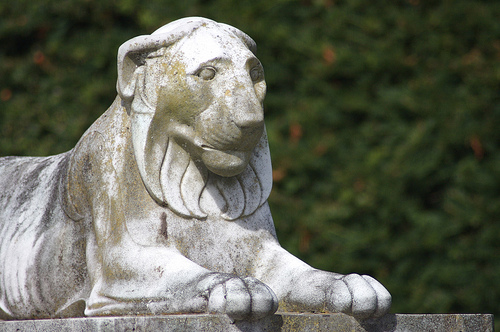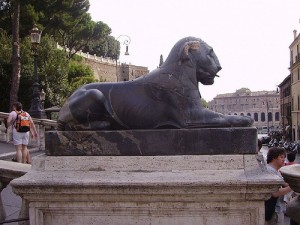Sometimes the simple explanation is the right one.
I have been spending some time on trying to explain the similarities between two sets of lion statues – one at De Paauw, the other at Drottningholm – through complicated family ties between the Dutch royal family, the Swedish royal family, and Tsar Alexander II. Another strand of research in the origin of these similarities was the German architect Wentzel who first worked in Stockholm, and later in Wassenaar at De Paauw.
All that can be cast overboard after discovering that the same type of lion roams the gardens of Powerscourt in Ireland. I cannot tie this place and it’s its owners (the Wingfield family) to either Dutch or Swedish gardens or families.

The tale has now officially become one of a litter – or a nest – of lions.
Last year, someone casually mentioned the existence of workshops producing (garden) statues in bulk during the 19th century. I knew about that, but had my doubts about these statues, mainly because of the distinct differences in ‘finish’ the lions at De Paauw and Drottningholm had: very smooth for the Dutch examples, where the Swedish lions have a more rugged exterior. The ones in Ireland seem to have a slightly different finish as well, but they unmistakably derive from the same model.
Sometimes the simple explanation (workshops and mass production) really is the right one. But does it answer all questions?
The lions at Powerscourt were placed there between 1850 and 1867, when Mervyn E. Wingfield (1836-1904; 7th Viscount of Powerscourt) transformed the terraced garden into what it is now. That coincides with the periods in which the lions were installed at De Paauw, and probably at Drottningholm.
We know from De Paauw that the lions allegedly were a gift from Tsar Alexander to the Dutch Prince Frederik in the 1850’s. I have assumed the Drottningholm lions could have been a wedding gift to Carl V Carl XV and Prince Frederik’s daughter Louise of Orange Nassau (they are placed behind the theatre that had been out of use for a long time, but was reused by the young pair during the 1860s). The almost simultanuous appearance suggests the statues at all three gardens must have come from the same workshop. But that does not seem to be the case.
The story of the lions at Powerscourt tells us what the original model was, but not where the bulk of these statues was produced. At the end of his life, Mervyn E. Wingfield wrote a description of Powerscourt, in which he meticulously mentions the plans and concepts used to create the garden; the ideas that have been thrown out the window and the materials used to create what was carried out; as well as the provenance of his statues and gates. It is not often that we have access to such a rich account of the creation – maybe ‘assembly’ is a better word – of a garden by the creator himself. The result is a wonderful source of information, which also tells us something about the ‘parents’ of the nest. Wingfield says in his description:
“On each side of the steps are four couchant lions, designed after those at the foot of the steps of the ascent to the Capitol at Rome (…).” 1Mervyn E. Wingfield, A Description and History of Powerscourt, London (1903), p88.
The lion on the left is one of these Roman examples. It is indeed similar to the ones in Wassenaar and Stockholm, although the finish is slightly different to them: the Powerscourt lions seem to be the most litteral copies of the Roman examples, including the line around the shoulder.
But looks deceive. Alterations have been made in the production of the Irish copies, as is clarified when Wingfield continues his sentence:
“(…) , also designed by Mr. Penrose, of a smaller size than the originals.”
The lions at Powerscourt are thus adapted and custom-made by a local person closely involved with the creation of the garden. It would be great to find out whether the lions at De Paauw and at Drottningholm are really similar in size and scale to their Roman examples. If so, not only a common source, but also a common workshop could be found.
A tape measure, anyone in Sweden and in Rome? I’ll do the ones in Wassenaar…
(edited for spelling and a mistake)
Footnotes
| ↑1 | Mervyn E. Wingfield, A Description and History of Powerscourt, London (1903), p88. |
|---|



